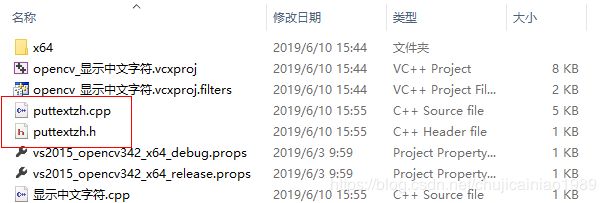opencv学习笔记-图片显示中文
运行环境:
vs2013、opencv3.3、win10-64bit
下载显示中文类:
OpenCV默认是不支持显示中文字符的,于是网上有人自己写了一个类实现,只需要下载到自己的代码文件中,添加头文件就可以通过调用函数来显示中文了。
1)显示中文类下载链接:(若链接失效,文字最后有源码)
百度网盘:https://pan.baidu.com/s/1gdYatLLOKmDI-_6OOzdQNg
提取码:o7p7
2)下载后文件名为:“puttextzh.cpp”,“puttextzh.cpp”
3)将这两个文件加入到项目文件夹中,并加入工程中
4)使用时加入头文件“puttextzh.h”
函数原型:
void putTextZH(
cv::Mat &dst,
const char* str,
cv::Point org,
cv::Scalar color,
int fontSize,
const char* fn,
bool italic,
bool underline
)参数解释:
dst:输入,原图像,即待加中文的图像;
str:中文字符串;
org:字符串像素点位置:
color:字符串颜色;
fontSize:字体大小;
fn:字体类型(默认Arial字体类型):
italic:斜体(默认无斜体):
underline:下划线(默认无下划线):
示例代码:
在lenna图像坐标为(50,60)位置加上字符串“我的名字叫lenna”,字体颜色:白色,字体大小:40,字体类型:微软雅黑
putTextZH(srcImg, "我的名字叫lenna", Point(50, 60), Scalar(255, 255, 255), 40, "微软雅黑");
#include
#include"opencv2/opencv.hpp"
#include"opencv2/highgui/highgui.hpp"
#include"puttextzh.h"
using namespace std;
using namespace cv;
int main()
{
Mat srcImg = imread("E:\\Project\\opencvPicture\\lenna.jpg");//打开图像
if (srcImg.empty())//判断是否正确打开图片
{
cout << "加载图像失败!" << endl;
return -1;
}
imshow("原图", srcImg);//显示原图
putTextZH(srcImg, "我的名字叫lenna", Point(50, 60), Scalar(255, 255, 255), 40, "微软雅黑");//图像上加中文
imshow("原图加中文", srcImg);
waitKey(0);
return 0;
} 运行结果:
中文类库源码:
puttextzh.cpp
#include "puttextzh.h"
#include "windows.h"
void GetStringSize(HDC hDC, const char* str, int* w, int* h)
{
SIZE size;
GetTextExtentPoint32A(hDC, str, strlen(str), &size);
if (w != 0) *w = size.cx;
if (h != 0) *h = size.cy;
}
void putTextZH(cv::Mat &dst, const char* str, cv::Point org, cv::Scalar color, int fontSize, const char* fn, bool italic, bool underline)
{
CV_Assert(dst.data != 0 && (dst.channels() == 1 || dst.channels() == 3));
int x, y, r, b;
if (org.x > dst.cols || org.y > dst.rows) return;
x = org.x < 0 ? -org.x : 0;
y = org.y < 0 ? -org.y : 0;
LOGFONTA lf;
lf.lfHeight = -fontSize;
lf.lfWidth = 0;
lf.lfEscapement = 0;
lf.lfOrientation = 0;
lf.lfWeight = 5;
lf.lfItalic = italic; //斜体
lf.lfUnderline = underline; //下划线
lf.lfStrikeOut = 0;
lf.lfCharSet = DEFAULT_CHARSET;
lf.lfOutPrecision = 0;
lf.lfClipPrecision = 0;
lf.lfQuality = PROOF_QUALITY;
lf.lfPitchAndFamily = 0;
strcpy_s(lf.lfFaceName, fn);
HFONT hf = CreateFontIndirectA(&lf);
HDC hDC = CreateCompatibleDC(0);
HFONT hOldFont = (HFONT)SelectObject(hDC, hf);
int strBaseW = 0, strBaseH = 0;
int singleRow = 0;
char buf[1 << 12];
strcpy_s(buf, str);
char *bufT[1 << 12]; // 这个用于分隔字符串后剩余的字符,可能会超出。
//处理多行
{
int nnh = 0;
int cw, ch;
const char* ln = strtok_s(buf, "\n",bufT);
while (ln != 0)
{
GetStringSize(hDC, ln, &cw, &ch);
strBaseW = max(strBaseW, cw);
strBaseH = max(strBaseH, ch);
ln = strtok_s(0, "\n",bufT);
nnh++;
}
singleRow = strBaseH;
strBaseH *= nnh;
}
if (org.x + strBaseW < 0 || org.y + strBaseH < 0)
{
SelectObject(hDC, hOldFont);
DeleteObject(hf);
DeleteObject(hDC);
return;
}
r = org.x + strBaseW > dst.cols ? dst.cols - org.x - 1 : strBaseW - 1;
b = org.y + strBaseH > dst.rows ? dst.rows - org.y - 1 : strBaseH - 1;
org.x = org.x < 0 ? 0 : org.x;
org.y = org.y < 0 ? 0 : org.y;
BITMAPINFO bmp = { 0 };
BITMAPINFOHEADER& bih = bmp.bmiHeader;
int strDrawLineStep = strBaseW * 3 % 4 == 0 ? strBaseW * 3 : (strBaseW * 3 + 4 - ((strBaseW * 3) % 4));
bih.biSize = sizeof(BITMAPINFOHEADER);
bih.biWidth = strBaseW;
bih.biHeight = strBaseH;
bih.biPlanes = 1;
bih.biBitCount = 24;
bih.biCompression = BI_RGB;
bih.biSizeImage = strBaseH * strDrawLineStep;
bih.biClrUsed = 0;
bih.biClrImportant = 0;
void* pDibData = 0;
HBITMAP hBmp = CreateDIBSection(hDC, &bmp, DIB_RGB_COLORS, &pDibData, 0, 0);
CV_Assert(pDibData != 0);
HBITMAP hOldBmp = (HBITMAP)SelectObject(hDC, hBmp);
//color.val[2], color.val[1], color.val[0]
SetTextColor(hDC, RGB(255, 255, 255));
SetBkColor(hDC, 0);
//SetStretchBltMode(hDC, COLORONCOLOR);
strcpy_s(buf, str);
const char* ln = strtok_s(buf, "\n",bufT);
int outTextY = 0;
while (ln != 0)
{
TextOutA(hDC, 0, outTextY, ln, strlen(ln));
outTextY += singleRow;
ln = strtok_s(0, "\n",bufT);
}
uchar* dstData = (uchar*)dst.data;
int dstStep = dst.step / sizeof(dstData[0]);
unsigned char* pImg = (unsigned char*)dst.data + org.x * dst.channels() + org.y * dstStep;
unsigned char* pStr = (unsigned char*)pDibData + x * 3;
for (int tty = y; tty <= b; ++tty)
{
unsigned char* subImg = pImg + (tty - y) * dstStep;
unsigned char* subStr = pStr + (strBaseH - tty - 1) * strDrawLineStep;
for (int ttx = x; ttx <= r; ++ttx)
{
for (int n = 0; n < dst.channels(); ++n){
double vtxt = subStr[n] / 255.0;
int cvv = vtxt * color.val[n] + (1 - vtxt) * subImg[n];
subImg[n] = cvv > 255 ? 255 : (cvv < 0 ? 0 : cvv);
}
subStr += 3;
subImg += dst.channels();
}
}
SelectObject(hDC, hOldBmp);
SelectObject(hDC, hOldFont);
DeleteObject(hf);
DeleteObject(hBmp);
DeleteDC(hDC);
}puttextzh.h
#ifndef PUTTEXTZH_H_
#define PUTTEXTZH_H_
//#include "opencv.hpp"
#include "opencv2/opencv.hpp"
void putTextZH(cv::Mat &dst, const char* str, cv::Point org, cv::Scalar color, int fontSize,
const char *fn = "Arial", bool italic = false, bool underline = false);
#endif // PUTTEXT_H_参考:https://blog.csdn.net/mars_xiaolei/article/details/91381148


